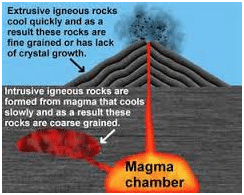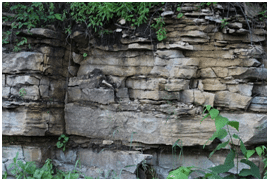Sedimentary, Igneous, and Metamorphic Rocks
Grade 7 Science Worksheets
How the rocks are formed?
Rocks are made up of substances called minerals. Any naturally occurring solid substance with a definite chemical composition is called a mineral.
All rocks are formed in the Earth’s lithosphere, which includes the Earth’s crust and the top part of its mantle, where partially molten rock called magma flows very slowly under the crust.
Some rocks are formed when magma gets close to the surface and slowly cools.
Some of that red-hot magma breaks through the Earth’s crust to form fiery volcanoes, releasing lava to cool quickly on the surface or even underwater.
Other rocks form as a result of the weathering of older rocks and erosion, creating layers of sediments, which are eventually buried under more sediment and changed by heat and pressure.
Some rocks are even formed from the remains of living things.

Credit: https://riosuerte.files.wordpress.com/2013/03/rock_cycle_.jpg
Schedule a Free session to clear worksheet doubts
No credit card required, no obligation to purchase.
Just schedule a FREE Sessions to meet a tutor and get help on any topic you want!
How do you classify igneous, sedimentary and metamorphic rocks?
There are three major classes of rocks – igneous, sedimentary and metamorphic.
Igneous Rocks
Rocks that form from the cooling of magma below the Earth’s crust or lava are called igneous rocks.
Igneous rocks that form from red-hot lava above the Earth’s surface are called extrusive rocks.
Igneous rocks that form from the lava spilling from underwater volcanoes are also classified as extrusive rocks.

Credit : https://pixabay.com/en/volcanic-rock-volcanic-rock-pumice-1720550
- How quickly the lava or magma cooled.
- What substances it contains.

Credit:https://commons.wikimedia.org/wiki/File:Igneous_rock_eng_text.jpg
Sedimentary rocks
Rocks that are formed from the particles of sediments are called sedimentary rocks.
Sediments are deposited when weathered rock is moved from one place to another by the wind, running water, the sea or glaciers. That process is called erosion.
Deposits of dead plants and animals are also called sediments.
Sand deposited by the wind forms sand dunes, especially in coastal areas where sand is picked up and blown inland until it is stopped by obstacles such as rock or vegetation.

Credit: http://www.coolkidfacts.com/wp-content/uploads/2014/11/sedimentation.png
The larger particles, such as gravel and sand, settle first. By the time the river reaches the sea, it is usually travelling so slowly that the very fine mud particles begin to settle.
During floods when rivers break their banks, sediments are deposited on flat, open land beside the river. These plains are called floodplains. The water in fast ‑moving rivers, along with the weathered rock it takes with it, can carve out deep valleys in the Earth’s surface.
One of the most spectacular examples of this is the Grand Canyon in Arizona, USA.
In the coldest regions of the Earth, especially at high altitudes, bodies of ice called glaciers slowly make their way down slopes.
Metamorphic rocks
Igneous and sedimentary rocks deep below the Earth’s surface are buried under the huge weight of the rocks, sediments and soil above them.
They are also subjected to high temperatures. The temperature increases by about 25°C for every kilometer below the surface.
This heat and pressure can change the composition and appearance of the minerals in rocks.
The process of change in the rocks is called metamorphism and
the rocks that are formed by these changes are called metamorphic rocks.

Credit: https://commons.wikimedia.org/wiki/File:Verdite_(microcrystalline_fuchsite_metamorphite)_South_Africa.jpg
Learn more about Sedimentary, Igneous, and Metamorphic Rocks and other important topics with 7th Grade Science Tutoring at eTutorWorld. Our expert science tutors break down the topics through interactive one-to-one sessions. We also offer the advantage of customized lesson plans, flexible schedules and convenience of learning from home.
Personalized Online Tutoring from eTutorWorld
eTutorWorld offers affordable one-on-one live tutoring over the web for Grades K-12, Test Prep help for Standardized tests like SCAT, CogAT, MAP, SSAT, SAT, ACT, ISEE and AP. You may schedule online tutoring lessons at your personal scheduled times, all with a Money-Back Guarantee. The first one-on-one online tutoring lesson is always FREE, no purchase obligation, no credit card required.
For answers/solutions to any question or to learn concepts, take a FREE TRIAL Session.
No credit card required, no obligation to purchase.
Just schedule a FREE Sessions to meet a tutor and get help on any topic you want!
Check Point
A. Fill in the blanks –
- Rocks are made up of substances called ………….
- Rocks that form from the cooling of magma below the Earth’s crust or lava are called ……………. …………
- Rocks that are formed from the particles of sediments are called……………… rocks.
- A fast-moving river is likely to carry with it sand, gravel and smaller particles. As it slows down on its path to the sea, the river loses energy and particles are deposited, forming ……………….
- The process of change in the rocks is called metamorphism and the rocks that are formed by these changes are called ………………. rocks.
B. State True or False –
- All rocks are formed in the Earth’s atmosphere, which includes the Earth’s crust and the top part of its mantle.
- Sediments are deposited when weathered rock is moved from one place to another by the wind, running water, the sea or glaciers. That process is called metamorphism.
- Rocks that form from the cooling of magma below the Earth’s crust or lava are called igneous rocks.
- The heat and pressure can change the composition and appearance of the minerals in rocks.
- Deposits of dead plants and animals are also called sediments.
Answer Key
A. Fill in the blanks –
- Mineral
- Igneous Rocks
- Sedimentary
- Sediments
- Metamorphic Rocks
B. State True or False –
- False
- False
- True
- True
- True
Learn more about Scientific Method and other important topics with 7th Grade Science Tutoring at eTutorWorld. Our expert science tutors break down the topics through interactive one-to-one sessions. We also offer the advantage of customized lesson plans, flexible schedules and convenience of learning from home.
Pricing for Online Tutoring
| Tutoring Package | Validity | Grade (1-12), College |
|---|---|---|
| 5 sessions | 1 Month | $124 |
| 1 session | 1 Month | $25 |
| 10 sessions | 3 months | $239 |
| 15 sessions | 3 months | $354 |
| 20 sessions | 4 months | $449 |
| 50 sessions | 6 months | $1049 |
| 100 sessions | 12 months | $2049 |
6th Grade Free Worksheets
- Elements & Compounds
- Solar Energy
- Photosynthesis
- Digestive System
- Electricity and Magnetism
- Law of conservation of energy
- Law of Conservation of Mass
- Periodic table
- Properties of Matter
- Waves
- Energy Resources
- Weather and Climate
- Immune, Circulatory and Digestive Systems
- Organs in Multi-cellular Organisms
- Sedimentary, Igneous, and Metamorphic Rocks
- Structure of the Earth
- Physical and Chemical Changes
- Scientific Method
- Cycles in Nature
- Environmental Science
- Renewable and Non-renewable energy Resources
- Characteristics of Living Organisms
- Life Science
- Earth and Space Science
- Solar Eclipse
- Heat Technology
- Newton’s Laws of Motions
- Physical Science
- Tools, Measurement and SI Units
- Earth Atmosphere
- Interactions of Living things
- The Earth Ecosystem
- Organelles in Plant and Animal cells
- Layers of the Earth


